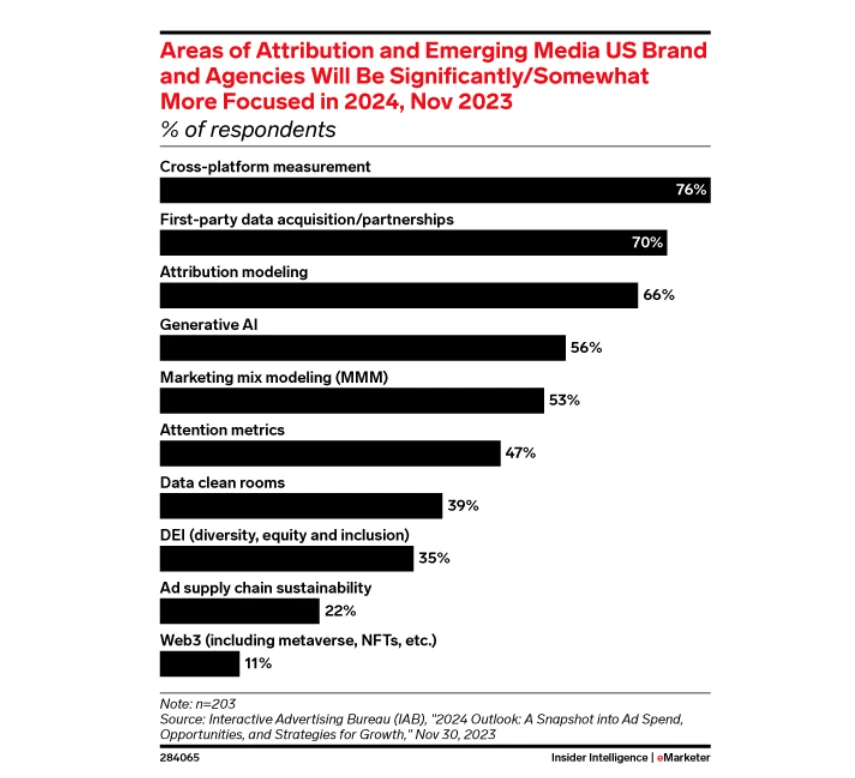“The true art of memory is the art of attention.” – Samuel Johnson, poet, playwright, literary critic.
How much attention do we give to ads, whether digital, outdoor, print, TV, or anywhere they pop up saying, ‘Look at me, look at me?’ Isn’t that what advertisers want to know?
With an ever-increasing focus on privacy, many traditional attribution metrics are becoming less dependable. At the same time, leaders are looking for more exact measurements and ROI proof. See the issue there?
What is Attention?
According to the ANA (Association of National Advertisers), the attention metric can be defined as “the likelihood of attention being paid to an ad placement” to measure performance.
Attention currently means many different things to many people: action taken, time given, or focused viewing. It depends on a brand’s goal. Attention may also be described as a combination of engagement measurements, such as conversions, bounce, completion, CTR, etc. It has been chiefly adopted for CTV and social media advertising, with gaming, DOOH, and audio being considered.
As advertisers, you want to know that viewers see and connect with your ad. A connection can be either clicking through and engaging with deeper content, converting as a lead or sale, or spending enough visual energy (time) that they will recall the brand the next time they come across it again. To put it simply, did they absorb the ad? And then, how do you measure that?

How to Measure Attention?
For now, attention is measured by viewability, reach, and VCR (view completion rate) when used for video advertising.
This is not a simple process like measuring website visits or CTR. Considering all it takes to measure attention, it may not be possible for SMB marketers with limited resources.
Attention measurement systems include biometric indicators, such as facial expressions, eye movement, skin conduction, heart rate, and even iris scanning. Eye tracking records gaze and focus. In eye-tracking studies, the data is fed into machine learning models, and then a proxy signal is layered on top. The data is then applied to a web page to review where ads appeared along with other placement elements.
You can see now why attention measurement is not for everyone and why some in the ad industry may consider it a trend, vanity metric, or even a placebo rather than a cure for unqualified measurement.
Some processes used to measure attention are more accessible, like attention heat maps. With heat maps, a tool is layered on a website to record where visitors’ eyes are moving, or at least where they are moving their cursor, and how long they hold in one place. That method may show dwell time, scroll speed, and completion rates as attention signals.
Yan Liu, CEO of TVision, told AdExchanger that Javascript tags embedded in the creative fire a pixel to the ad server to measure video attention. The pixels tell how long a video is played, the level of volume, and engagement.
Who is Using Attention?
Companies like Amplified Intelligence and Adelaide Metrics are working with holding companies to test an attention metric option for their advertisers. The New York Times began testing the opportunity with its own proprietary metric and an Adelaide partnership using their collection of attention measurement tools.
DSPs like The Trade Desk and Amazon are also testing with Adelaide and Lumen to offer advertisers the option.

Issues with Attention as a Metric
Attention may be the most elusive measurement method as people are inundated with content, leading to shorter and shorter attention spans. In a recent conversation with a Vision Media client, he named “attention” his biggest competitor—not the competing business down the street but getting through all the noise customers wade through daily.
Infillion’s Eyes Wide Shut report on Traversing the Attention Spectrum stated that their survey found that almost half of media buyers believe the current attention measurement processes don’t address ad avoidance and multitasking.
Ad avoidance refers to viewers ignoring or skipping ads, while multitasking is engaging in multiple activities simultaneously, which can reduce the viewer's attention to the ad. The report also states that media buyers need to be convinced that attention is the right tool for optimization.
Attention vs. Viewability
Is attention greater than viewability, reach, or VCR? Some want to replace viewability with attention. They believe attention adds performance to the investment, while viewability just informs you where to place your media.
Other marketers believe viewability is not going anywhere. A clearer definition, process, and structure would need to be developed around attention. It may be part of a larger strategy and not a standalone measurement.
Are we jumping on attention because we lack other quality metrics? Is attention too vague a concept? If your priority KPIs are sales, sign-ups, and then clicks and visits, is attention too early in the customer journey, and does it show value on ROI?
The end goal will always be sales. Attention may be an additional signal, but it says more about your creative, audience target, and placement than it does about your business's growth.
Using attention as THE metric isn’t a magic elixir for measuring campaign success. There are too many ways to define and measure it. And knowing something has value is different from knowing how to harness that value.
Additional Sources:
https://www.outbrain.com/blog/attention-metrics
https://www.thecurrent.com/attention-metrics-digital-advertising-measurement
Main Image: pexels-seanpatrickphotography-1069588.jpg




